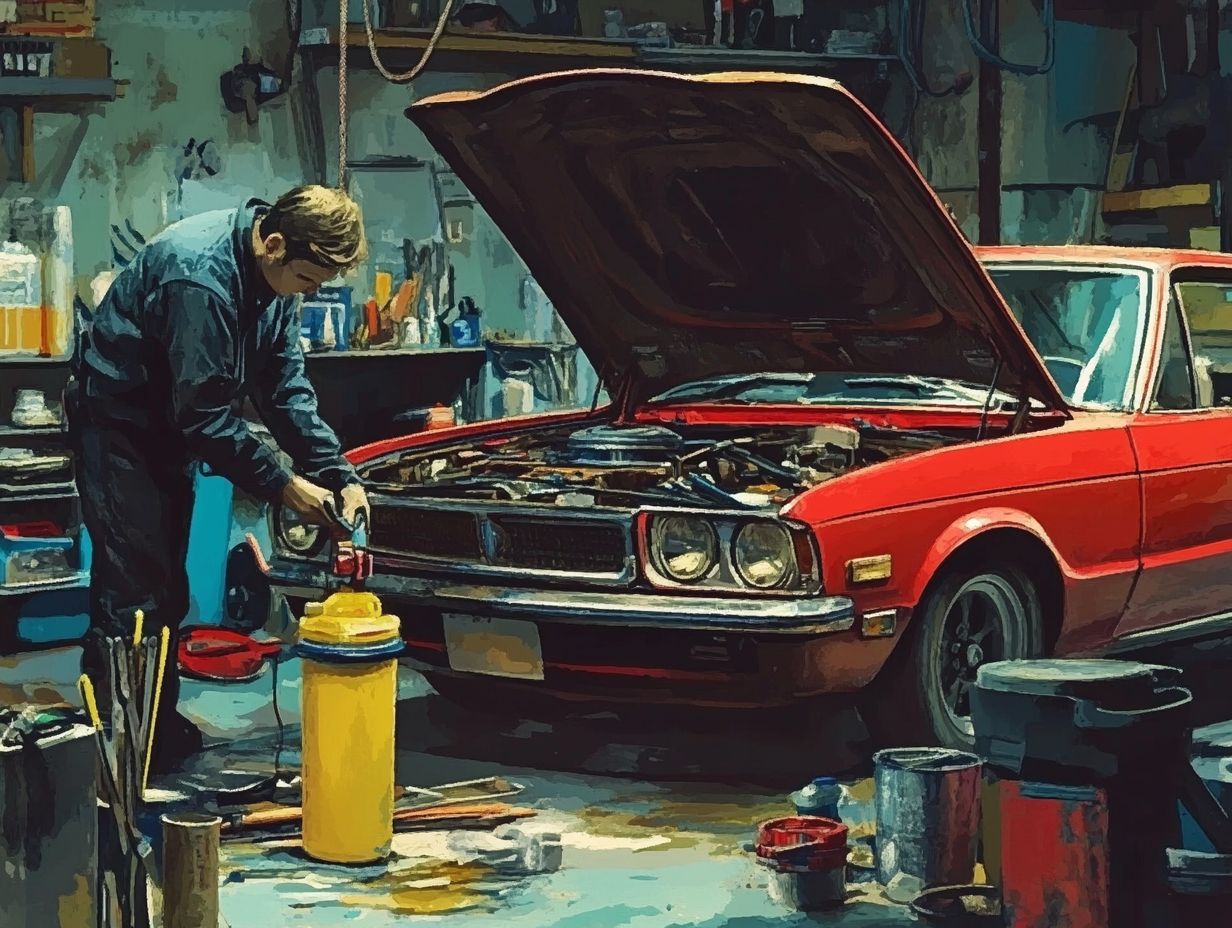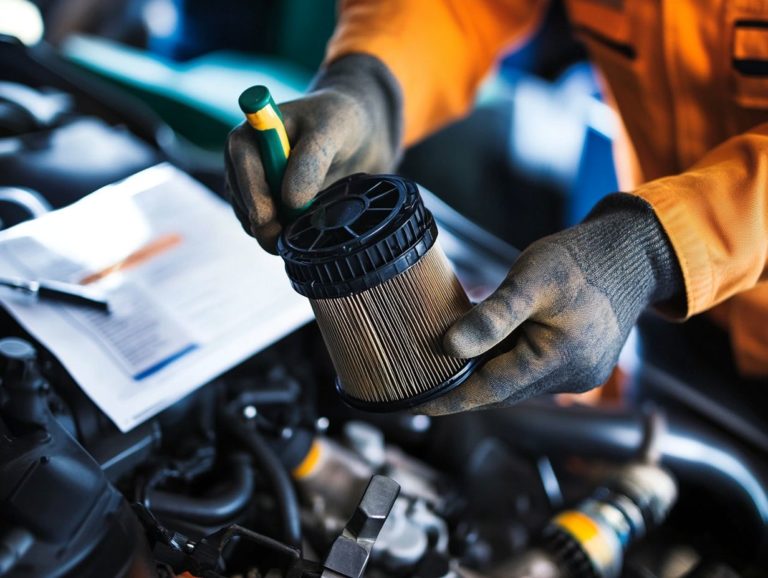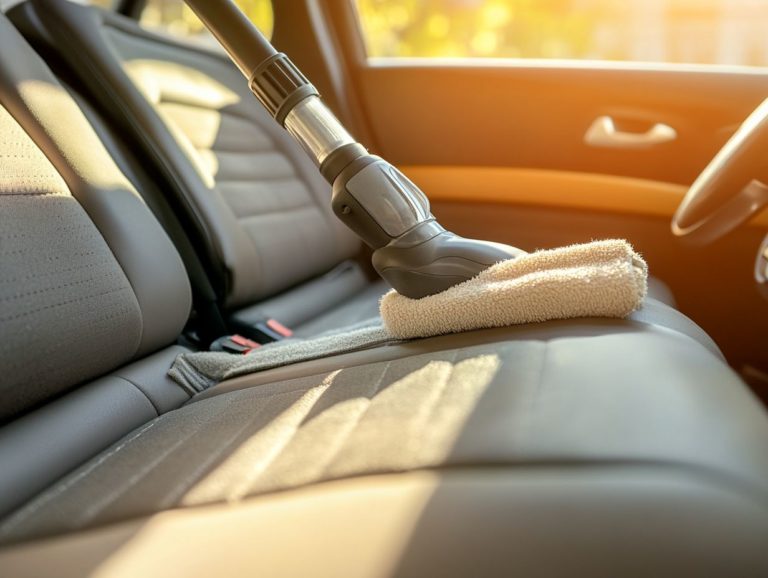DIY Oil Change: A Beginner’s Guide
Changing your own oil might appear intimidating at first. However, it s a rewarding and cost-effective skill that every car owner should embrace. Not only can it save you money, but it also equips you with a deeper understanding of your vehicle’s maintenance needs.
This guide provides everything you need to embark on this journey. You’ll find essential tools, materials, and a comprehensive step-by-step process for a successful oil change.
You’ll also discover valuable tips to sidestep common pitfalls, ensuring that your experience is both smooth and safe.
Are you ready to roll up your sleeves and dive in? Let s get started!
Contents
Key Takeaways:

- Save money and gain valuable skills by doing your own oil change.
- Key tools and materials needed for a successful oil change include a wrench, oil filter, and oil drain pan.
- Proper preparation, caution, and following step-by-step instructions can make the DIY oil change process smooth and successful.
Why You Should Consider Doing It Yourself
Doing a car oil change yourself can be a rewarding experience. It not only saves you money but also deepens your understanding of your vehicle. With the right tools and some knowledge about motor oil and oil filters, you can easily tackle this essential aspect of car maintenance.
This approach enhances your engine’s longevity and performance while fostering a sense of accomplishment. You ll create a stronger bond with your vehicle, whether it s a Chevrolet, Honda, Toyota, or any other make.
Many car owners have found that performing oil changes themselves can lead to significant savings often a hefty sum that mechanics typically charge for labor. One individual recounted how skipping the service center not only kept cash in their pocket but also provided valuable insights into their vehicle s needs.
If you re new to this, gather the right tools to make the process smooth and easy. A wrench set and an oil filter wrench are essential. Don t forget to read your vehicle s manual; it contains vital information about the type of motor oil and filter replacement guidelines. This makes the entire process simpler and more effective.
Tools and Materials Needed
To execute a successful car oil change, gather the right tools and materials. This ensures a smooth process that minimizes mess and maximizes safety.
Start by securing essential items like a funnel for pouring motor oil and oil catch pans to contain the old oil. Don t forget jack stands for safely elevating your vehicle and a selection of proper tools such as filter pliers and oil filter wrenches.
Having safety glasses and disposable gloves protects you from spills and debris while you work under the car.
Essential Items for a Successful Oil Change
For a successful oil change, gather a few essential items: quality motor oil, the right oil filter, and tools like an oil filter wrench, funnel, and a wrench for the oil drain plug.
Selecting the right motor oil according to your vehicle s specifications is crucial. This ensures optimal engine performance and longevity. Investing in high-quality oil filter supplies prevents leaks and ensures that impurities are effectively filtered from the engine oil.
Think about how thick the oil should be for your vehicle and if synthetic oil is better for your driving conditions.
When choosing an oil filter, opt for options that meet manufacturer standards. Double-check compatibility with your vehicle model for the best results.
Your tools should be sturdy and user-friendly to streamline the process. Don’t overlook the benefits of having a drain pan and shop towels within reach. These will help you manage spills and make cleanup a breeze.
Taking the time to gather these items wisely can significantly boost the efficiency of your oil change. It prolongs your engine s life and saves you both time and money down the road.
Start your DIY oil change today and feel empowered by your car care skills!
Step-by-Step Guide to Changing Your Oil
Changing your oil is a careful process that ensures your vehicle operates at its best and enjoys a longer lifespan. This guide will lead you through each phase of the oil change, starting with preparing your car and ending with a thorough check of the oil level. This way, you’ll meet your vehicle s oil capacity requirements.
Whether you drive a Ford, Nissan, or any other make, understanding your vehicle s specific needs is essential for a successful oil change.
Preparing Your Vehicle

Before you begin the oil change, it’s crucial to prepare your vehicle for safety and efficiency. Start by warming up the engine slightly; this helps the oil drain more smoothly.
Gather your safety glasses and disposable gloves to protect yourself during the process. Elevate the car using jack stands for easy access to the oil drain plug and oil pan.
Secure the area around your vehicle to prevent slips or accidents, especially in tight spaces. Have a collection container ready to catch the used oil. Check the owner s manual for the correct oil change procedure and the type of oil your vehicle requires.
Keep a funnel handy for a hassle-free refill of fresh oil. Remember to recycle your used oil at a local recycling center or auto shop!
Draining and Replacing the Oil
Draining and replacing the oil is a crucial step in the oil change process. Carefully remove the oil drain plug and let the old oil flow into a designated container. Once you ve drained all the old oil, pour in the new motor oil, following your vehicle’s specifications regarding oil capacity.
After replacing the drain plug, check for leaks before disposing of the old oil responsibly.
Gather the tools you’ll need: an adjustable wrench, a funnel, and a clean container for the old oil.
- Ensure the engine is cool before removing the drain plug. Position your container under the oil pan to catch the draining fluid.
- Turn the plug counterclockwise and let the old oil flow out completely. This may take a few moments. Once fully drained, screw the drain plug back on tight.
- When pouring the new oil with a funnel, use the recommended type to optimize engine performance.
- After the oil change, start the engine briefly to circulate the new oil, then check for any leaks around the plug.
Gather the used oil in a sealed container and take it to a local recycling facility, honoring environmental practices!
Replacing the Oil Filter
Replacing the oil filter is a vital step in the oil change process. It ensures your engine operates smoothly and efficiently.
Start by gathering the tools you’ll need: the oil filter tool, a new oil filter, and a container for the old oil. Run the engine for a few minutes to warm it up, making it easier to loosen the filter.
Once warmed, turn off the engine and position the oil container underneath. Use the oil filter tool to grip the old filter tightly and twist it counterclockwise to remove it.
Apply a thin layer of new oil to the rubber gasket on the new filter. This helps create a tight seal and prevents leaks. Secure the new filter by hand, ensuring it s snug, and refill the oil if needed.
Check the oil levels with the dipstick to confirm you’ve added the right amount for optimal engine performance.
Tips for a Smooth DIY Oil Change
A seamless DIY oil change is within your reach when you equip yourself with practical tips from this step-by-step guide and avoid common missteps.
Create an oil change checklist to enhance your efficiency. Write down all materials you need from resetting the oil life monitor to inspecting for leaks post-replacement.
By understanding typical pitfalls, you can enrich your DIY experience while extending your vehicle’s longevity. If you have questions about any steps, don’t hesitate to ask!
Common Mistakes to Avoid
Many DIYers stumble into common traps that can hurt their engine s performance! When you’re tackling a DIY oil change, it’s crucial to check oil levels before adding new motor oil. Neglecting this step can lead to overfilling.
Using the wrong type of motor oil could mean you’re not meeting your vehicle s specifications. Steering clear of these missteps is essential for a smooth and efficient engine after the oil change.
Another frequent blunder is overlooking the oil filter change. Skipping this step allows old oil to mix with the new, jeopardizing lubrication and potentially leading to engine wear.
Improper disposal of used oil poses environmental risks and can lead to legal troubles. Many DIY enthusiasts underestimate the significance of using the right tools, like a torque wrench, which is essential for tightening bolts without stripping the threads.
These factors highlight the importance of being vigilant at every stage of the oil change process.
Maintenance and Safety Precautions

When you embark on a DIY oil change, prioritizing maintenance and safety precautions is essential for both your vehicle and your well-being. It’s important to know what to check during a DIY oil change.
Always wear safety glasses and use the proper tools throughout the process to minimize risks. Having the correct oil change supplies ready before you begin can streamline the task and enhance your experience.
How Often to Change Your Oil
Understanding how often to change your oil is crucial for maintaining your vehicle’s performance and extending its lifespan. Many modern cars come equipped with an oil life monitor that provides tailored recommendations based on your driving habits.
A good rule of thumb is to check your oil levels regularly and consider changing the oil every 3,000 to 7,500 miles, depending on the type of motor oil you use. Always consult your vehicle’s manual for precise guidance on oil change frequency.
Several factors can impact this timeline, especially if you drive in extreme conditions, such as heavy traffic or extreme temperatures. Frequent short trips or navigating stop-and-go traffic may necessitate more frequent oil changes since the engine might not reach optimal temperatures to effectively burn off contaminants.
The quality of the oil you choose is paramount. Synthetic oils generally provide superior protection and allow for longer intervals between changes compared to conventional oils. Monitoring your oil life monitor readings offers personalized insights tailored to your driving habits, ensuring your engine stays in peak condition.
Proper Disposal of Used Oil
Proper disposal of used oil is essential for safeguarding the environment and complying with local regulations. Always store your old oil in a sealed container labeled as ‘Used Motor Oil’ and take it to a recycling center that accepts used motor oil to minimize your environmental footprint.
Many auto parts stores offer disposal services, making it simple to responsibly discard your old oil after a DIY oil change. Ensure the container is leak-proof to prevent contamination of other materials.
Familiarize yourself with local regulations regarding hazardous waste disposal; improper disposal can lead to fines and harm the environment.
Some communities organize special collection events for hazardous materials, providing a great opportunity for safe disposal. Consider reusing the oil to conserve resources and protect your environment today!
Remember, a single small action can have a significant impact on preserving our ecosystems.
Frequently Asked Questions
Wondering what a DIY oil change is?
A DIY oil change is when you change the oil in your vehicle yourself, rather than taking it to a mechanic or an oil change service. It can save you money and give you a better understanding of your vehicle’s maintenance needs.
Why should I do a DIY oil change?

Changing your own oil is not only a smart way to save money, but it also feels great to take care of your vehicle yourself! You control the type and quality of oil used, ensuring the best for your car.
What tools do I need for a DIY oil change?
For a DIY oil change, gather a socket wrench, oil filter wrench, and a funnel. You should also have a container to catch the old oil, rags, and gloves to keep your hands clean.
Can I use any type of oil for my DIY oil change?
No, you must use the type of oil recommended by your vehicle’s manufacturer. Find this information in your owner’s manual.
How often should I do a DIY oil change?
Change your oil every 3,000 to 5,000 miles or every 3 to 6 months, whichever comes first. Don’t wait too long; regular oil changes keep your engine running smoothly!
What are the steps for a DIY oil change?
The general steps include draining the old oil, replacing the oil filter, adding new oil, and checking the oil level. Follow these steps carefully and dispose of the old oil properly.
Ready to get started? Grab your tools and give it a try!






